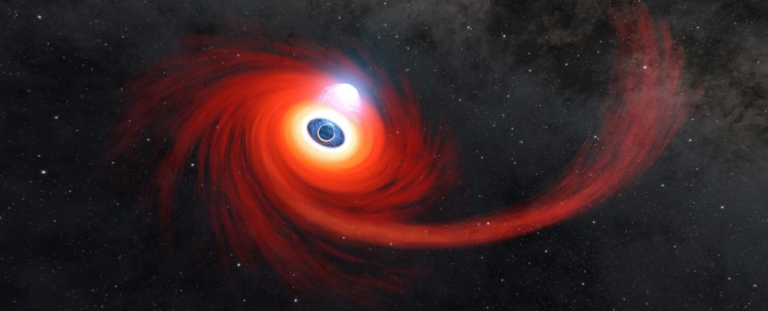In the Vast Expanse of Space, a Black Hole Astonishingly Ignites into a Spectacular Display
A Supermassive Black Hole Awakens in the Distant Depths of the Observable Universe
From the outermost reaches of the known cosmos, astronomers have recently witnessed a remarkable spectacle—a supermassive black hole spontaneously bursting into luminous activity.
The radiant brilliance emanating from a time 10 billion years in the past indicates that this compact entity abruptly initiated a voracious consumption of immense quantities of matter. Scientists assert that this event ranks among the most awe-inspiring instances of such phenomena ever witnessed.
Presenting their findings at the UK’s annual National Astronomy Meeting, a team led by astronomer Samantha Oates from the University of Birmingham in the UK unveiled their groundbreaking discovery. The research will also be published in the Monthly Notices of the Royal Astronomical Society and is currently accessible on the preprint server arXiv.
Dubbed J221951-484240, or simply J221951, the eruption has garnered attention as a mesmerizing occurrence in the scientific community. “In recent years, our understanding of the diverse behaviors exhibited by supermassive black holes has significantly expanded, encompassing discoveries of stars being torn asunder and accreting black holes showcasing profoundly variable luminosities,” explains astrophysicist Matt Nicholl from Queen’s University Belfast in Ireland. “J221951 represents one of the most extraordinary examples thus far, catching us off guard with its intensity.”

Deep within each galaxy resides a colossal black hole, yet their behavior is not constant. Some, such as Sagittarius A* at the heart of the Milky Way, remain relatively tranquil, lacking sufficient surrounding matter to sustain a substantial feeding rate.
Nevertheless, the activity of supermassive black holes undergoes fluctuations on cosmic time scales, switching on and off when new material becomes available.
While searching for a different kind of transient outburst—a kilonova event resulting from the fusion of neutron stars—Oates and her colleagues stumbled upon the discovery of J221951. Despite initially matching the expected color, the signal emitted by J221951 persisted for a longer duration than anticipated, unlike the fading nature of kilonovae that typically lasts a few days.
Upon closer examination, the researchers made a significant realization: the distance traveled by the emitted light was far greater than initially presumed—10 billion years instead of 500 million. This led them to trace the flare back to the core of a galaxy situated in that specific location in both space and time.
Furthermore, this revelation unveiled an astonishing truth—the flare possessed an exceptional luminosity, aligning not with a solitary explosion but with a continuous radiance generated by material swirling in the extreme environment surrounding a supermassive black hole as it plunges into its gravitational grip.
The suddenness of the flare, along with its luminosity, strongly indicated that the black hole had abruptly transitioned from a dormant state to an intensely active phase, engorging itself with copious amounts of newly acquired matter.
Two plausible explanations have been put forth to account for this phenomenon. The first proposes that the black hole commenced its feeding process by devouring material swirling in a nearby disk that had finally approached within range, transforming the black hole into an active galactic nucleus. The second explanation involves a more violent scenario, where a star ventured too close to the black hole, resulting in its destruction and subsequent consumption in what is referred to as a tidal disruption event.
To determine which hypothesis is more likely, further observations are required. “In the future, crucial clues will be obtained to differentiate between the scenarios of a tidal disruption event and an active galactic nucleus,” affirms Oates.
She further explains, “For instance, if J221951 is associated with an active galactic nucleus undergoing activation, we would anticipate its fading to cease and its brightness to increase once again. On the other hand, if J221951 is a tidal disruption event, we would expect its luminosity to continue diminishing. Monitoring J221951 over the coming months to years will be necessary to capture its behavior in the later stages.”
The comprehensive findings will be published in the Monthly Notices of the Royal Astronomical Society and are currently accessible on arXiv, a preprint server.
Do not forget to share your opinion with us to provide you with the best posts !




0 Comments